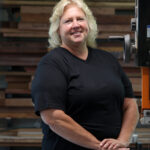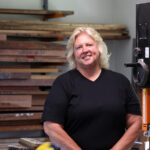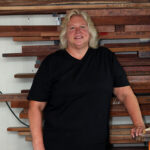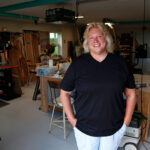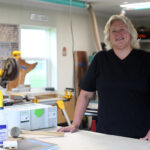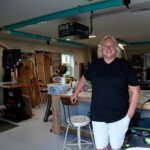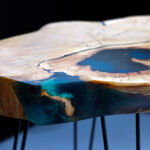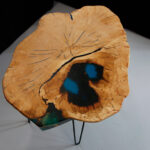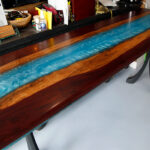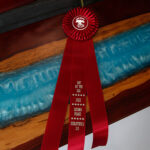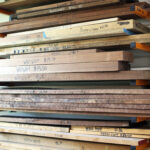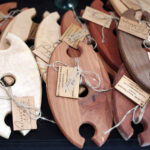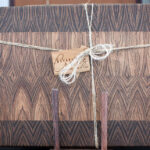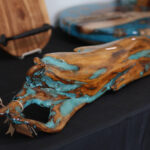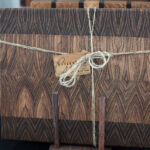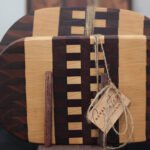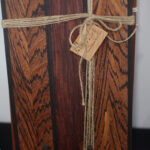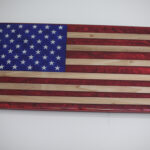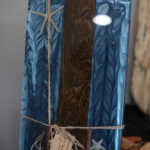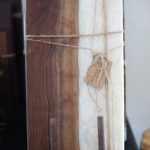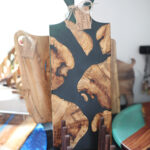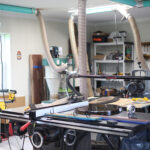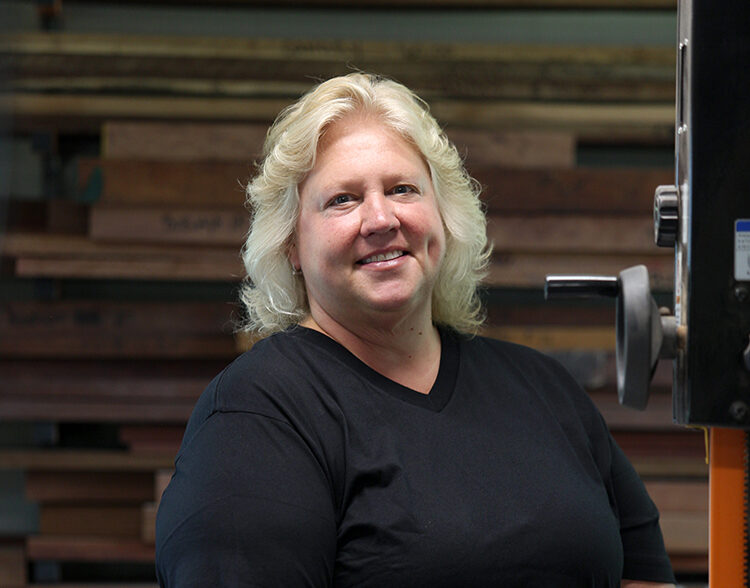
Woodworking artist Michelle Nevaeh rocketed into distinction on the Vero Beach Neighborhood Facebook group recently, getting 12,000 hits on one post in one week, something the folks who run it say has never happened before. Add to that 300 likes and hundreds of comments. The hits are a clear indication of the uniqueness of the art that Nevaeh produces.
A former executive chef, classically trained at the Culinary Institute of America in New York, Nevaeh says she no longer dreams about the next gastronomic dish to wow her clients, as she once did. These days Nevaeh dreams of designing and crafting some of the most interesting pieces imaginable, all made out of wood.
A true woodworker, Nevaeh says she loves the process of cutting, sawing and book-matching pieces of wood into unique designs.
But Nevaeh adds another element to the mix – epoxy. Although wood and epoxy might seem to be alien materials, when thrown together by her highly creative eye they combine to make works of art out of everyday items such as cutting boards, charcuterie boards, music boxes, and totally rad tables, coined Live Edge River Tables.
Nevaeh explains that after her daughter was born, she no longer wanted to work the demanding evening and weekend hours of the restaurant industry, so she became a manufacturer’s representative selling non-food items to restaurants and resorts.
As such, Nevaeh traveled around the world while representing over 30 companies. She was even able to bring her daughter to China to see how “China” plates are made.
“It was quite the experience. I did very well with it and had fun with it, but I missed the creative outlet,” says Nevaeh, who lived in western Massachusetts for 25 years.
After her daughter grew up, Nevaeh took a step back to decide what she wanted to do next.
“I ended up falling into woodworking, oddly enough. It’s funny, I started with a lot of drawings doing Zentangles [a method of drawing intricate designs that combines meditation and art] and saw some videos on lasering,” says Nevaeh. The videos gave her the idea to laser her designs on assorted items.
“I did a few woodworking projects with the laser, making music boxes, chess boards and stuff like that. Working with the wood brought me back to my childhood, when I often worked with my grandfather on his woodworking projects,” says Nevaeh, who was raised in Bernardsville, N.J. It could also be fate. Her middle name is Wood, her Scottish grandmother’s maiden name.
“I found it very relaxing and enjoyed the beauty of the different grains of wood and the different species, and getting to learn all of that, and one thing led to another.”
While watching videos on woodworking and wood turning, she remembered having read an article a few years prior about a woman who was versed in the craft.
“I Googled her and found the woman, Rosanna Coyne, a well-known woodcarver, who ended up living only 2 miles from me.”
After asking the woman if she could talk to her, “She invited me over to see her workshop and encouraged me to go for it.”
Although concerned about making money, in her mind thinking, “What if I hate it? What if I’m horrible at it?” she says: “Coyne assured me the equipment really holds its value and you can turn around and sell it at not much of a loss. She gave me a couple of lessons here and there, and the courage to make the investment.”
That led to a few classes, lots more videos and a whole lot more trial and error. Nevaeh has basically taught herself the craft, her inherent creativity coming into full throttle.
“Now I dream about things to make out of wood. A lot comes to me at night.”
After tinkering around with woodworking up north, Nevaeh eventually felt Florida might be a better fit for clientele. Having had a vacation home on the ocean in Vero Beach for 17 years, her family was quite familiar with the attributes of the town.
“I’ve loved the area and the beach. I need beach time for my peace of mind.”
Another draw was Vero’s large art community.
“I love the museum, and how much the community supports the arts, whether it’s theater or comedy or paintings. It’s just a very artistic community, and when I got it in my head to do this I just wanted to be here.”
Nevaeh says her family enjoys the arts scene as well. Her now-grown daughter, who was also sprinkled with creative genes, is into the performing arts, writing screenplays and songs.
While Nevaeh enjoys all variety of woodworking, her favorite is creating wood and epoxy tables. Her aptly named Live Edge River Tables appear as if a river runs down the middle. The tables are made from Granadillo wood, an exotic hardwood from Central America and the Brazilian Amazon. Very dense and hard, it is considered by some to be superior to teak or mahogany.
Nevaeh cuts the Granadillo planks down the center and the two halves are then reversed, so the outside “live edge” points inward. Once the bark is stripped away, the light-beige part just underneath, called sapwood, resembles a sandy beach next to a center of poured blue epoxy, which looks like water.
Nevaeh says she needs to keep an eye on the poured epoxy like a new puppy, with frequent checks even through the night, and regular stirring until it sets to her liking.
“It needs a lot of babysitting. It’s like a living being until it is totally dry.”
Although it is labor intensive and time-consuming, the result yields beautiful, unique tables.
It is not an inexpensive venture, either. Epoxy costs $175 per gallon, and some tables can take 10 gallons or more. A bar could take 30 gallons. The wood slabs, too, can run into serious money, depending on the quality and thickness of the wood and the species. The legs, which run the full price gamut, are another expense.
As a result, each table is as unique in design as it is in price, and each is a usable piece of artwork.
As with cooking, Nevaeh says, “you can give the same recipe to five people, and it will come out five different ways. It’s the same with woodworking and epoxy. The two mediums together give you endless possibilities.”
Nevaeh likes the epoxy to be a highlight to the wood, preferring a higher ratio of wood to epoxy, as the character of the wood is so unique.
Defects in the wood, what Nevaeh calls “punky spots,” are often filled in with epoxy, such as with charcuterie boards, and she also crafts driftwood and epoxy sculptures. One customer, a former “American Idol” contestant, asked to have guitar picks set in epoxy for a rack to hang his guitars on.
“I use a lot of exotic wood distributors that ship in from all over the world,” she says.
Additionally, she gets some wood from her next-door neighbor, a gentleman who also has a cabin and wood mill in North Carolina. He brings trailer loads to Vero to sell to Nevaeh and other Florida woodworkers.
Wherever it’s from, however, the price is now higher than pre-pandemic days and, with shipping issues, harder to get, but her understanding of the complex wood market has helped her navigate it.
A huge workshop poster showing the ‘Janka’ Scale, which rates the hardness and density of each species, hangs on her wall as an essential guide to help pick the correct wood for its chosen use. For example, cutting boards need a hardness rating of 800 to 2,000.
Wood that is too hard will dull knives but would be good for a desktop.
Nevaeh’s exhibit at this year’s Under the Oaks was very well received, and she won second place in the sculpture category at the Vero Beach Art Club’s 2022 Art by the Sea Show and Sale at the Vero Beach Museum of Art.
Neveah, whose business card is a small piece of wood with laser-carved details, gives tours of her workshop by appointment.
Photos by Kaila Jones

